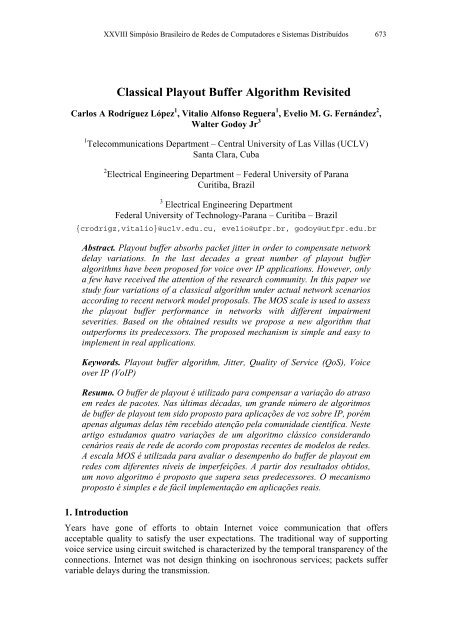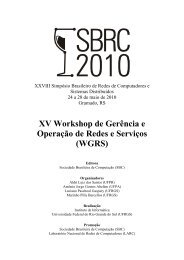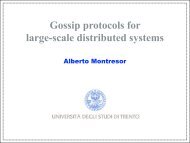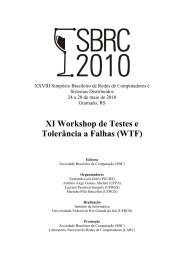Classical Playout Buffer Algorithm Revisited
Classical Playout Buffer Algorithm Revisited
Classical Playout Buffer Algorithm Revisited
You also want an ePaper? Increase the reach of your titles
YUMPU automatically turns print PDFs into web optimized ePapers that Google loves.
XXVIII Simpósio Brasileiro de Redes de Computadores e Sistemas Distribuídos 673<br />
<strong>Classical</strong> <strong>Playout</strong> <strong>Buffer</strong> <strong>Algorithm</strong> <strong>Revisited</strong><br />
Carlos A Rodríguez López 1 , Vitalio Alfonso Reguera 1 , Evelio M. G. Fernández 2 ,<br />
Walter Godoy Jr 3<br />
1 Telecommunications Department – Central University of Las Villas (UCLV)<br />
Santa Clara, Cuba<br />
2 Electrical Engineering Department – Federal University of Parana<br />
Curitiba, Brazil<br />
3 Electrical Engineering Department<br />
Federal University of Technology-Parana – Curitiba – Brazil<br />
{crodrigz,vitalio}@uclv.edu.cu, evelio@ufpr.br, godoy@utfpr.edu.br<br />
Abstract. <strong>Playout</strong> buffer absorbs packet jitter in order to compensate network<br />
delay variations. In the last decades a great number of playout buffer<br />
algorithms have been proposed for voice over IP applications. However, only<br />
a few have received the attention of the research community. In this paper we<br />
study four variations of a classical algorithm under actual network scenarios<br />
according to recent network model proposals. The MOS scale is used to assess<br />
the playout buffer performance in networks with different impairment<br />
severities. Based on the obtained results we propose a new algorithm that<br />
outperforms its predecessors. The proposed mechanism is simple and easy to<br />
implement in real applications.<br />
Keywords. <strong>Playout</strong> buffer algorithm, Jitter, Quality of Service (QoS), Voice<br />
over IP (VoIP)<br />
Resumo. O buffer de playout é utilizado para compensar a variação do atraso<br />
em redes de pacotes. Nas últimas décadas, um grande número de algoritmos<br />
de buffer de playout tem sido proposto para aplicações de voz sobre IP, porém<br />
apenas algumas delas têm recebido atenção pela comunidade científica. Neste<br />
artigo estudamos quatro variações de um algoritmo clássico considerando<br />
cenários reais de rede de acordo com propostas recentes de modelos de redes.<br />
A escala MOS é utilizada para avaliar o desempenho do buffer de playout em<br />
redes com diferentes níveis de imperfeições. A partir dos resultados obtidos,<br />
um novo algoritmo é proposto que supera seus predecessores. O mecanismo<br />
proposto é simples e de fácil implementação em aplicações reais.<br />
1. Introduction<br />
Years have gone of efforts to obtain Internet voice communication that offers<br />
acceptable quality to satisfy the user expectations. The traditional way of supporting<br />
voice service using circuit switched is characterized by the temporal transparency of the<br />
connections. Internet was not design thinking on isochronous services; packets suffer<br />
variable delays during the transmission.
674 Anais<br />
To solve this problem in VoIP connections a playout buffer is used. It serves as a<br />
temporal store for audio packets, absorbing delay variations and allowing the<br />
reproduction of the audio payload free of jitter. This operation introduces an additional<br />
delay. To establish the buffer size is an important task that has a tremendous impact in<br />
the packet loss rate and in the interactivity of the conversation.<br />
A considerable number of algorithms exist for adaptive playout buffer, a classification<br />
can be found in [Atzori and Lobina 2006] and [Narbutt, et al 2005]. The existing<br />
solutions have been evaluated using real audio packet traces or by means of discrete<br />
event simulations. Recently it was suggested in [ITU-T 2007] a model that statistically<br />
evaluates multimedia transmission performance over IP networks. In this paper a<br />
comparative study was carried out using packet traces generated according to [ITU-T<br />
2007].The performance of the algorithms is evaluated using de MOS scale computed<br />
through the E-model [ITU-T 2003]. Finally we propose a new playout buffer algorithm<br />
based on a classical mechanism described in [Ramjee et al 1994]. The obtained results<br />
evidences that our algorithm outperforms its predecessors with minimal computational<br />
cost.<br />
The remainder of this paper is structured as follows. Section 2 provides useful<br />
background for our work, including a brief description of four classical playout buffer<br />
algorithms; as well as the models used to generate audio packet traces and assesses the<br />
offered quality of service for voice communications. In Section 3 we reexamine the<br />
performance of typical playout buffers discovering an important regularity that has not<br />
been previously reported to the best of our knowledge. Based on this finding, in Section<br />
4 we propose a new algorithm that achieves the highest score. Section 5 concludes the<br />
paper.<br />
2. Background<br />
2.1 <strong>Playout</strong> <strong>Buffer</strong> <strong>Algorithm</strong>s<br />
During the last decades several algorithms have been introduced for the playout buffer.<br />
One of the top referenced algorithms by the research community is the one presented by<br />
Ramjee et al (1994). This algorithm adjusts the parameters of the playouts between<br />
audio bursts. Its basic functioning can be described as follow: for every incoming<br />
packet the mean network delay ( dˆ i ) and mean delay variation ( vˆ i ) are estimated, if the<br />
received packet is the first one in a talkspurt then the absolute delay p o is calculated as:<br />
p<br />
o<br />
= dˆ<br />
+ Ω ⋅ vˆ<br />
(1)<br />
i<br />
where Ω is set to 4 in the original implementation. For the ith packet in a talkspurt the<br />
reproduction time is set to:<br />
p i = ti<br />
+ po<br />
(2)<br />
where t i is the time stamp set by the transmitter. Four different algorithms have been<br />
proposed to estimate the mean network delay and are summarized in Figure 1.<br />
<strong>Algorithm</strong> 1 calculated the mean network delay using an approach suggested by<br />
[Jacobson V. (1988)] for estimating the round-trip-time in TCP connections. This<br />
i
XXVIII Simpósio Brasileiro de Redes de Computadores e Sistemas Distribuídos 675<br />
Figure 1. Pseudocode for <strong>Algorithm</strong> 1, 2, 3 and 4.<br />
algorithm uses an exponential weighted moving average whit a weighting factorα . The<br />
second algorithm (<strong>Algorithm</strong> 2) introduces a small modification to the first algorithm,<br />
changing the weighting factor α by β (a lower one) when the actual network delay<br />
exceeds its estimate. The idea is to react more quickly when the network delay increase.<br />
<strong>Algorithm</strong> 3 stands on a different approach, setting the estimated mean network delay to<br />
the minor network delay observed during a talkspurt. Finally, <strong>Algorithm</strong> 4 is designed<br />
to adapt fast enough to delay spikes. According to Ramjee et al (1994) this algorithm<br />
success to increase their delay estimate on detection of a spike and again to decrease<br />
their estimate once the spike is over.<br />
The delay variation estimate remains the same in the four algorithms and is calculated<br />
as:<br />
vˆ = vˆ<br />
− + (1−<br />
) dˆ<br />
1 α − n<br />
(3)<br />
i<br />
i<br />
where n i is the network delay experienced by packet i and α is chosen according to the<br />
selected algorithm (see Figure 1).<br />
Several research studies have been devoted to find a better estimate for the network<br />
delay [DeLeon and Sreenan 1999], [Sreenan 2000], [Narbutt, and Murphy 2004].<br />
However, little work has been done with respect to the impact of the Ω coefficient in<br />
i<br />
i
676 Anais<br />
the performance of the algorithms. In this paper we propose a simple mechanism to<br />
dynamically adapt the value of Ω .<br />
2.2 Statistical Network Transmission Model<br />
Recommendation ITU-T P.1050 [ITU-T 2007] specifies an IP network model and<br />
scenarios for evaluating and comparing communications equipment connected over a<br />
converged wide area network. The test scenarios combine LAN, access and core<br />
network elements in a realistic way to create layer 3 IP network impairments that cause<br />
packets to experience varying delay or loss. In our work we use this recommendation to<br />
generate audio packet traces.<br />
2.3 Performance assessment<br />
Mean opinion score has been traditionally used to measure subjective perception of<br />
voice communication. MOS is given on a scale of 1-5, where a higher value<br />
corresponds to better quality. Since MOS is a subjective test difficult to be carried out<br />
in practical situations, some other objective tests have been developed. ITU<br />
recommendation G.107 describes the E-model [ITU-T 2003], a computational algorithm<br />
that incorporates impairment factors present in modern transmission networks. The<br />
output of the E-model is a scalar quality rating value, R, which is computed as:<br />
R = Ro − Is − Id − Ie-eff + A<br />
(4)<br />
⎧1<br />
R < 0<br />
⎪<br />
⎪<br />
−6<br />
MOS CQ = ⎨1<br />
+ 0.035R<br />
+ R(<br />
R − 60)(100 − R)7<br />
⋅10<br />
0 < R < 100 (5)<br />
⎪<br />
⎪<br />
⎩4.5<br />
R > 100<br />
where Ro represents, in principle, the basic signal-to-noise ratio, Is is a combination of<br />
all impairments which occur more or less simultaneously with the voice signal, Id<br />
represents the impairments caused by delay, Ie-eff represents impairments caused by<br />
low bit-rate codecs and also includes impairment due to packet losses, and A is the<br />
advantage factor. An estimated Mean Opinion Score for the conversational situation in<br />
the scale 1-5 can be obtained from the R-factor using equation (5). Table 1 shows the<br />
relation between R-value, MOS and user satisfaction.<br />
Table 1. Equivalent R values into estimate MOS<br />
User satisfaction<br />
R factor<br />
(lower<br />
limit)<br />
MOS<br />
(lower<br />
limit)<br />
very satisfied 90 4.34<br />
satisfied 80 4.03<br />
some user dissatisfied 70 3.60<br />
many user dissatisfied 60 3.10<br />
nearly all user dissatisfied 50 2.58
XXVIII Simpósio Brasileiro de Redes de Computadores e Sistemas Distribuídos 677<br />
3. <strong>Classical</strong> <strong>Algorithm</strong>s Performance<br />
3.1 Experiments Setup<br />
The performance of the four playout buffer algorithms is assessed using statistical<br />
models. The network scenario used in the evaluation process is depicted in Figure 2.<br />
Eight packet traces were generated with different network impairment severities<br />
according to [ITU-T 2007] (see Table 2 for details). The size of the audio packets was<br />
fixed to 200 bytes (160 byte corresponding to 20 ms of audio plus 40 byte of protocols<br />
overhead) to simulate a G.711 codec. Voice activity detection was implemented by<br />
means of speech models provided in [ITU-T 1993].<br />
Tx<br />
LAN<br />
Access<br />
Core<br />
Network<br />
Access<br />
LAN<br />
Rx<br />
Figure 2. Network diagram.<br />
Table 2. Trace details<br />
Trace 1 2 3 4 5 6 7 8<br />
Impairment<br />
LAN occupancy (%) 1 2 3 5 8 12 16 20<br />
Access occupancy (%) 0 1 2 4 8 15 30 50<br />
MTU (bytes) 512 512 1508 1508 1508 1508 1508 1508<br />
Route flap interval (s) 0 3600 1800 900 480 240 120 60<br />
Route flap delay (ms) 0 2 4 8 16 32 64 128<br />
Core Delay (ms) 16 32 64 128 196 256 512 768<br />
Jitter (ms) 5 10 24 40 70 100 150 500<br />
Link fail interval (s) 0 3600 1800 900 480 240 120 60<br />
Link fail duration (ms) 0 64 128 256 400 800 1600 3000<br />
Packet loss (%) 0 0.01 0.02 0.04 0.1 0.2 0.5 1<br />
Reordered packets (%) 0 0.00025 0.0005 0.001 0.005 0.01 0.05 0.1<br />
Audio packet traces were passed through the playout buffer to estimate the mean<br />
mouth-to-ear delay and the overall packet loss rate. Finally, using these two parameters<br />
we compute the mean opinion score for conversational quality.
678 Anais<br />
Figure 3. <strong>Algorithm</strong> performance varying the Ω (Omega) coefficient.
XXVIII Simpósio Brasileiro de Redes de Computadores e Sistemas Distribuídos 679<br />
3.2 <strong>Algorithm</strong>s comparison and discussion<br />
In this section we compare the four classical playout buffer algorithms by varying the<br />
Ω coefficient. The MOS values obtained are shown in Figure 3. The horizontal dashed<br />
line corresponds to the upper bound of the MOS which is computed using the mean<br />
network delay and packet loss rate just before the playout buffer. Obviously for each of<br />
the four algorithms the audio quality degrades as the network impairment severities<br />
increase. However, the algorithms behave in different ways with respect to Ω ; in<br />
several cases Ω = 4 do not produce the best result. Particularly <strong>Algorithm</strong> 2, for<br />
specific values of Ω , always achieves the best mean opinion score. These values are<br />
marked using a vertical dotted line.<br />
The experiments reveal two interesting results in the case of <strong>Algorithm</strong> 2. The first one<br />
and more evident is that set Ω to 4 is not the best option for most of the sample audio<br />
traces. The second one is less evident and can be observed in Figure 4. In this figure we<br />
plot the values of Ω that maximize the MOS as a function of the mean network delay<br />
estimated by the algorithm. Now results quite obvious that exists an inverse relationship<br />
between the best value of Ω for the algorithm and the mean network delay. The Ω<br />
value decreases as the end-to-end network delay increases (i.e. when network<br />
impairment severities increase). This can be explained by the fact that <strong>Algorithm</strong> 2<br />
adapts more quickly to burst of packet incurring in long delays. For that reason it tends<br />
to over estimate the mean network delay (see Figure 5). When a fixed amount of the<br />
jitter estimate is added to set the playout time the mouth-to-ear delay significantly<br />
increase.<br />
Therefore, as the network delay increases it is possible to reduce the quantity, Ω , of<br />
jitter estimate added to the playout buffer without incurring in a noticeable number of<br />
packets out of time. Note that an increase in both, the mouth-to-ear delay and the packet<br />
loss rate, degrade the quality of service.<br />
Figure 4. Best Ω (Omega) as a function of the estimate mean delay for<br />
<strong>Algorithm</strong> 2.
680 Anais<br />
Figure 5. Estimate mean delay increasing the network impairment severities.<br />
4. <strong>Algorithm</strong> 5<br />
Figure 6. <strong>Algorithm</strong> 5.<br />
Based on the above observations we propose a new algorithm, <strong>Algorithm</strong> 5, which<br />
dynamically adapts Ω to achieve better quality. Here we exploited the regularity found<br />
in <strong>Algorithm</strong> 2 (see Figure 4). The pseudocode for the algorithm is shown is Figure 6.<br />
The value of Ω is computed for the first packet of a talkspurt as<br />
⎛ ⎛ ⎞ ⎞<br />
⎜ ⎜<br />
a<br />
Ω = min max ⎟ ⎟<br />
⎜<br />
,1 , 10<br />
ˆ ⎟<br />
⎝ ⎝ d i ⎠ ⎠<br />
(6)
XXVIII Simpósio Brasileiro de Redes de Computadores e Sistemas Distribuídos 681<br />
where a is constant and was set to 200 in our experimental studies. This value was<br />
chosen to best fitting a large data set collected in various network scenarios with<br />
different network impairment severities.<br />
The idea is to reduce the values of Ω as the estimate network delay increases. The<br />
estimation of the network delay is the same as in <strong>Algorithm</strong> 2. The coefficient values<br />
are bounded between 1 and 10 since values out of that range lacks of practical use (e.g.<br />
Ω → ∞ as d ˆ → i 0 ) and has not a significant impact in the performance. A large value<br />
of Ω for short network delays not only provides the higher MOS score but also permits<br />
to adsorb sudden and large increases in the end-to-end network delay (e.g. spikes). As<br />
soon as the network delay remains high the value of Ω move toward 1 in order to<br />
compensate the over estimation introduced by <strong>Algorithm</strong> 2.<br />
Figure 7. Comparison of the five algorithms under different network impairment<br />
severities.<br />
A comparison between the original four algorithms ( Ω = 4) and <strong>Algorithm</strong> 5 is shown<br />
in Figure 7. <strong>Algorithm</strong> 5 exhibits the best performance followed by <strong>Algorithm</strong> 4 and 1<br />
in that order. This result is consistent with several studies that report <strong>Algorithm</strong> 4 to be<br />
the best ranking of the classical algorithms [Ramjee et al 1994], [Kansal and Karandikar<br />
2001], [Narbutt et al 2005]. It is important to note that the computational cost of<br />
<strong>Algorithm</strong> 5 is comparable to that of <strong>Algorithm</strong> 2 and less heavy than <strong>Algorithm</strong> 4. The<br />
quality gain results significant with respect to the four classical algorithms. Specifically<br />
in the range of moderate to intense network impairment severities our algorithm clearly<br />
outperforms the original Ramjee’s proposal.<br />
5. Conclusions<br />
In this paper we studied a classical playout buffer algorithm, exploring the effect of one<br />
of its parameters in the performance of the algorithm. This parameter has been<br />
traditionally skipped by the researches. Our results revealed an important unexploited<br />
regularity. Based on that knowledge we propose a new algorithm that achieves the<br />
highest score when compared to its classical predecessors. The proposed algorithm can
682 Anais<br />
bee carried out with minimal computational cost, resulting in a simple and easy way to<br />
implement a playout buffer mechanism for real multimedia applications.<br />
References<br />
Atzori, L and Lobina, M. L. (2006) “<strong>Playout</strong> <strong>Buffer</strong>ing IP Telephony: A Survey<br />
discussing Problems and Approaches” In IEEE Communications Surveys&Tutorials,<br />
pages 36-46<br />
DeLeon P. and Sreenan, C. J. (1999) “An Adaptive Predictor for Media <strong>Playout</strong><br />
<strong>Buffer</strong>ing,” In Proc. ICASSP, vol. 6, pages 3097–100.<br />
ITU-T Recommendation P.59, “Artificial Conversational Speach ,” 1993<br />
ITU-T Recommendation G.107, “The E-Model, a Computational Model for Use in<br />
Transmission Planning,” 03/2003.<br />
ITU-T Recommendation G.1050, “"Network model for evaluating multimedia<br />
transmission performance over Internet Protocol",” 11/2007.<br />
Kansal, A. and Karandikar A. (2001) “Jitter-Free Audio <strong>Playout</strong> Over Best Effort<br />
Packet Networks” In Proc ATM Forum, New Delhi, India.<br />
Narbutt, M. and Murphy, L. (2004) “Improving Voice Over IP Subjective Call<br />
Quality,” In IEEE Commun. Letters, vol. 8, no. 5 pages 308–10.<br />
Narbutt, M. Kelly, A. Murphy, L. and Philip, P. (2005) “Adaptative VoIP <strong>Playout</strong><br />
Scheduling: Assesssing User Satisfaction “In IEEE Internet Computing, vol .9, no 4 ,<br />
pages 28-34.<br />
Ramjee, R. and Kurose, J. and Towsley D. and Schulzrinne H. (1994) “Adaptive<br />
<strong>Playout</strong> Mechanisms for Packetized Audio Applications in Wide-Area Networks,” In<br />
Proc. INFOCOM, Toronto, Canada.<br />
Sreenan C. J. (2000) “Delay Reduction Techniques for <strong>Playout</strong> <strong>Buffer</strong>ing,” In IEEE<br />
Trans. Multimedia, vol. 2, no. 2 pages 88–100.<br />
Jacobson V. (1988) “Congestion avoidance and control,” In Proc ACM SIGCOMM<br />
Conf, Stanford, pages 314-329.







